Don't wanna be here? Send us removal request.
Video
youtube
Indigenous Lands & Resource Management Conference 2021.
Live Streamed on Youtube!
0 notes
Text
What did the Butterfly Say to the Caterpillar?
This semester has been an adventure of learning, exploring, and discovering my place as an interpreter. I identified traits of myself that can be powerful assets as an interpreter, using my positivity and sense of humor to invigorate a passion in my audience. Previously, I would have classified an interpreter as someone who just wants to thrust their facts and beliefs onto you, but interpretation is so much more than that. It is a skillful navigation of the audience and allowing the people who have taken the time to come and learn from you to walk away with a lasting impression. It is one thing to blabber about facts but to offer Gifts of Interpretation distinguishes good from great. In our textbook “Interpreting Cultural and Natural Heritage for a Better World” the author speaks of the gifts of interpretation; giving the audience the gift of Spark, of Story, of Provocation, of Revelation, of Relationship, and of Passion to name a few. These gifts are invaluable offerings. Take a moment and think about your childhood, can you pick a moment/event/person that said/did something that rooted a passion within you?

(There is always a different Perspective; Georgian Bay, ON - Photo by me)
I remember growing up every spring the White-throated Sparrow’s would fly back from their migration south and the would be singing outside. As a kid they were just birds making noise, but my dad would hum under his breath “Oh-Sweet-Canada-Canada-Canada”, I would call it the “sweet Canada bird” little did I know this would be the first of many birds calls I would learn by Mnemonics. I think that small things can leave a lasting impact and change the course of someone’s life.
As an interpreter, the opportunity to show people the beauty and wonders, to provoke new levels of seeing and enjoying the environment and to foster a sense of community with your audience. I truly believe that education is the basis of helping solve future issues such as climate change. The more people understand the more they are likely to make a difference whether it be big or small, every action counts.
Passion, Patience, Perspective, Perseverance and Positivity are the Five P’s that I attempt to emulate in my works as an interpreter. To have a Passion for the subject being interpreted, passion is something that exudes from a person, it is something intangible that you can just feel in the voice, body language and demeanor. Patience is needed for the thing that cannot be changed, you cannot make everyone appreciate and listen to everything you say or believe but to be patient and learn to appreciate and listen to other Perspectives. It is one thing to agree with someone who understands your perspective but to be able to value another’s perspective and/or to be able to explain your own perspective in a respectful way is a skill that everyone could refine. Perseverance is needed on those long days in inclement weather, or to keep pursuing your passions and goals that sometimes seem fruitless. Finally, last but not least is Positivity. This trait should not be discount, positivity can be infectious (kinda like the Corona virus); it can change the entire vibe of your presentation, it can inspire and open dialogue and connection between audience. There is an extra P, and that is Practice. To be an effective interpreter, I will need to practice and get experience under my belt. This is how I will grow confidence, skills, and effectiveness. Like the Butterfly said to the caterpillar “Give yourself Time”

Miigwech,
Nadine
0 notes
Text
That was a great final post Cassie!
I think you really hit the nail on the head when you identified the need for inclusion and identifying the items in our ”invisible backpack” to be able to respectively and effectively connect with our audience. I think another great tool for interpreting is to be able to question and have the audience reflect on the themes and topics being discussed. Our textbook “Interpreting Cultural and Natural Heritage for a Better World” identified 3 different types that are effective; using open ended questions, content related questions and direct or indirect questions. These tactics can help audience connect, feel like they are valued and experiences are relatable.
Furthermore, I also think that climate change and environmental conservation are very important as an interpreter to incorporate into our work. To identify relations, connections of how the natural world is all interconnected is a valuable perspective that can unify many. We have 1 planet, and we need to work together to make it a better place.
Final Blog Post
This week’s blog post is very important, as it requires us to reflect on what we have learned in this course and consider how this has shaped our beliefs as a nature interpreter. Writing this final blog post is a bittersweet task. I have thoroughly enjoyed this course because these blog posts have given us the opportunity to communicate our personal opinions on course themes, and they have allowed us to interact with each other and share our views on nature interpretation. Whether you are leading an interpretive hike or discussing ancient artifacts, this course has given us many tools that will be useful in the broad field of nature interpretation.

Brandywine Falls Provincial Park, British Columbia. Photo taken by me.
Ethics are defined as “moral principles that govern a person’s behaviour or the conducting of an activity” (Oxford Dictionary, n.d.). Each individual has a set of ethics that influence the decisions that they make in life. One’s ethics can change as they mature and encounter different experiences. It is important that nature interpreters acknowledge their personal ethics, and consider how their ethics may influence the delivery of their programs. Personally, I think it is important that my programs are inclusive and accessible to everybody who is interested in them, regardless of what their “invisible backpack” may hold. According to Peggy McIntosh, privilege is an “invisible knapsack of unearned assets” (McIntosh in Noel, 2000, p. 116). In unit three we learned about the role of privilege in achieving environmental education and how interpretative programs aren’t always accessible to everyone (Hooykaas, 2021). In the setting of nature interpretation, privilege can govern the experiences you have access to, the destinations you can travel to, and your level of comfort while participating. Thus, it is important to me that everyone who is in my interpretive program has access to the same experiences, regardless of their privilege. The role of a nature interpreter is to share their knowledge of the natural world with their audience, and this experience should not be affected by an individual’s age, race, gender, class, education, etc.

Photo Retrieved from https://hbr.org/2021/03/implementing-inclusive-policies-across-a-global-organization
One way to make nature interpretation more accessible to a wider audience is by using different methods of delivery. For example, someone who does not have the resources to attend an interpretive program at a provincial park may be able to watch a youtube video on the same topic and receive nature education this way. Chapter eight of the textbook discussed how to interpret to the masses and reach a wider audience via radio, social media and other outlets online (Beck et al., 2018). Additionally, the current pandemic has forced interpreters to come up with new ways to reach their audience, which has made the online delivery of nature interpretation more prominent. Thus, alternative methods of delivery (such as social media, podcasts and online videos) have the benefit of being accessible to a bigger audience and being accessed remotely.
Different methods of delivery are also advantageous because they can cater to different learning styles. In unit two, we learned about the diversity of learning styles and how to cater to audiences with different learning styles (Hooykaas, 2021). Personally, I am an auditory and tactile learner and I benefit from listening to someone explain a concept or idea. However, I think one of the major responsibilities of a nature interpreter is to acknowledge your audience’s learning style and adapt your programs to fit their needs (Hooykaas, 2021). In order to achieve this, it is helpful to use multiple learning theories in your programs to make your program suitable to a large diversity of learners (Beck et al., 2018). Approaches that I would include in my programs are items and artifacts that the audience can interact with, visual aids (such as diagrams) , auditory aids (such as a discussion) and activities that the audience can participate in. These approaches cater to auditory, visual and tactile learners (Hooykaas, 2021). According to Beck et al. (2018), multisensory learning is beneficial because it engages more senses which enhances learning. I think it is important to consider these things while developing interpretive programs in order to ensure that all participants can synthesize the information you are presenting.

My friend and I on a hike in Algonquin Park. Photo taken by me.
There are many responsibilities that come with being a nature interpreter. Primarily, I think it is important that you have all the first aid and safety qualifications required for your programs. For example, if you are leading a canoe trip it is critical that you have wilderness first aid training, ORCKA training, bear safety training, etc. As the trip leader and guide, you are responsible for the health and safety of your participants and need to be prepared for any situation. It is important that you can act well under pressure and know how to adapt to various dangers that may be encountered. Another major responsibility that interpreters have is to share accurate information with their audience. There is a lot of false information that circulates in the media, online platforms and social media. Thus, it is important that interpreters ensure that their audience is receiving correct information. When collecting information for my programs, I would use primary literature, and peer reviewed journals and have colleagues review my work to prevent the spread of false information.

A photo of me collecting water samples in Algonquin Park. We are always required to wear PFDs while working near water and we receive extensive training before starting field work (WHMIS, Bear safety training, Workplace health and safety training). Photo taken by my co-worker.
One of the elements of nature interpretation that I find particularly important is education on environmental conservation. It has been made evident that climate change is progressing, and this involves the simultaneous enhancement of environmental degradation. Therefore, it is critical that we, as interpreters, communicate accurate information regarding climate change to the largest audience possible, regardless of their “invisible backpack”. I have strong beliefs about how anthropogenic activities accelerate climate change, and environmental conservation is a topic that I am passionate about. Due to my beliefs, I will try to incorporate environmental education into my nature interpretation. As climate change proceeds, it becomes progressively important that environmental education and science education are synergistic (Wals et al., 2014). As a marine and freshwater biology student, it is my goal to spread awareness on climate change and how it impacts the health of aquatic ecosystems. This course has taught me how to use social media as an outlet to communicate my knowledge on climate change, and encourage my peers to get involved in making a difference.

My friend and I collecting zooplankton samples from the Woolwich Dam. This was used for our research project on the impact of dams (anthropogenic disturbances) on zooplankton alpha diversity in riverine systems. Photo taken by my group member.
Thank you for reading my post!
Cassie
References
Beck, L., Cable, T.T., & Knudson, D.M. (2018). Chapter 6: How people learn. Interpreting cultural and natural heritage for a better world. (pp.105-111). Sagamore Venture.
Beck, L., Cable, T.T., & Knudson, D.M. (2018). Chapter 8: Interpreting to the masses. Interpreting cultural and natural heritage for a better world. (pp.165-182). Sagamore Venture.
Hooykaas, A. (2021). Unit 3: Risk Versus Reward in Interpretation [Course Website]. University of Guelph Courselink. https://courselink.uoguelph.ca/d2l/le/content/666945/viewContent/2590559/View
Hooykaas, A. (2021). Unit 2: Teaching Learners [Course Website]. University of Guelph Courselink. https://courselink.uoguelph.ca/d2l/le/content/666945/viewContent/2583079/View
McIntosh, P. (2000). White privilege: Unpacking the invisible knapsack. In J. Noel’s (Ed.). Notable selections in multicultural education (pp. 115-120). Guilford, CT. Dushkin/ McGraw-Hill.
Oxford Dictionary. (n.d.). Retrieved March 28, 2021, from https://languages.oup.com/google-dictionary-en/
Wals, A., Brody, M., Dillon, J., & Stevenson, R. (2014). Science education. Convergence between science and environmental education. Science (American Association for the Advancement of Science), 344(6184), 583–584. https://doi.org/10.1126/science.1250515
7 notes
·
View notes
Text
What a “fire” post to end a great semester! I think you enumerated so many foundational qualities of a good interpreter. You’re story about the school yard pick resonated strongly with me. I played in a city wide spring basket ball league as a teen in high school. It was this fantastic way that took girls of a certain age bracket and placed them on teams with girls from other high schools and experience levels. As a fairly decent ball player, to me it was really important to play as a team, these were usually pretty unstructured games, we didn’t practice we just had fun and played basket ball. I have a fairly strong leadership personality, but also have a instinct to teach. This one year we had an exchange student from China on our team, she had never played basket ball before but she was eager to learn, ready to try anything, she wanted to make friends and have fun. That year we spend every game having the best time as a team playing, we all passed the ball, gave equal opportunity, made mistakes (and learnt from them). We would play these other teams that were so serious, and you could see the actual irritation it gave them to see us having so much fun, yet still giving them a run for their money. Because we had worked as a team all season, everyone's skills developed and we ended up in the finals during playoffs after losing every single game the entire season. I don’t really remember playing that game in particular but i do remember how much fun I had that whole spring basket ball season and I bet that every single girl on my team remembers it to.
I think this is super relatable to interpreting because the foundation of positivity, hard work, having fun lead to a path of growth, teamwork and bonding. If those same qualities can be reflected as an interpreter then I would say “you’re winning”.
My Journey as an Interpreter 🌿
Prior to this course, my view of nature was quite closed-minded. In fact, I perceived nature as simply a space to enjoy and relax during my downtime, for leisure activities, and as a place to take a breather from the stressful world around me. Although nature still provides this escape for me, I have also come to understand that the natural world is much, much more. I am grateful for this course because it has taught me to appreciate nature interpretation as a space for learning and growing as individuals and as a community. Nature is a welcoming place for all.
Throughout my journey as an interpreter, I have had many opportunities to reflect on my relationship with the natural world. Not only have I become more self-aware of my connection to nature, but I have also become more mindful of new perspectives of interpretation. According to Chapter 1 of Interpreting Cultural and Natural Heritage for a Better World, Canadian Yorke Edwards defines the essence of interpretive work, stating that “the job of interpretation is to open the minds of people so they can receive the interesting signals that the world is constantly sending” (Beck et al., 2018). I truly believe that nature evokes feelings that support a personal relationship with the cultural landscape. Effective interpretation needs to remain relevant and thought-provoking to the audience in order to nurture one’s personal connection to their natural surroundings.
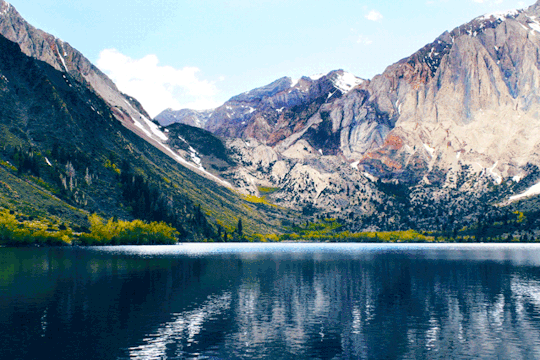
When I think about my own personal morals and core values, I realize that a lot of them are shared with the ethical beliefs of a good nature interpreter. I value honesty, integrity, and responsibility. I strive to stay creative, patient, and passionate. I cherish exploration, wonder, and ambition. These ethics that I have inherited from my parents, learned from friends and family, and discovered through my life journey are extremely important to me. As an interpreter, I wish to share my experiences and teachings with others while remaining true to my values and beliefs.
My responsibility as an interpreter is to make sure that everyone feels welcomed and included. Inclusion is a core value of mine and has been since I was young. In fact, growing up I played soccer and I recall one particular practice that still resonates with me. The coach selected two team captains to do a classic “school-yard pick” to create the two teams. I was chosen as one of the captains for that practice. We went along, going back and forth, choosing each player to join our team. At the end of the practice, the coach pulled me aside and said “I know what you did. I know that you choose all the girls first who were always chosen last to be a part of your team. And when I tell you how happy each of those girls looked - thank you.” To this day I always remember this moment, as what I thought was just a simple school-yard pick, turned out to make a major difference. I still strive to make each person feel included like those girls did that day. I wish for each person's contribution, big or small, to feel significant. As Maya Angelou once stated, “I've learned that people will forget what you said, people will forget what you did, but people will never forget how you made them feel.” Thus as an environmental interpreter, I wish to create an experience that will leave participants with a stronger sense of belonging. In particular, I can do this by encouraging others to share their personal thoughts, opinions, and experiences with nature. It is so important that I create safe spaces for other nature interpreters where they can feel comfortable to openly explore new perspectives in a communal environment.
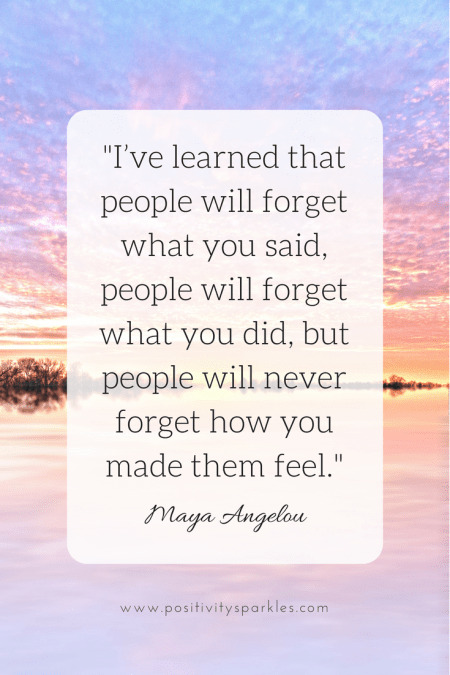
Retrieved from: LINK
Another responsibility I have as an environmental interpreter is to understand the numerous ways that people learn. This deeper understanding will allow me to better organize experiences in a cohesive way that others will remember and find meaningful (Beck et al., 2018). Specifically, it is imperative to comprehend diverse learning styles and multiple intelligences in order to provide a deeper learning experience for each unique individual.
My approach to environmental interpretation is foremost rooted in artistic expression. Specifically, I intend to use my passion for art and creative design to inspire others to establish a deeper emotional connection with their surroundings. As noted by Jay Griffiths, “Art elicits sympathy, conjures empathy, and these emotions are requisites for a kind, kinned sense of society… for the greatest artists do not make their best works of art in clay or paint or sound or words; they make them right inside us, within the heart of the reader or audience” (Beck et al., 2018). Knowing this, I hope to use the power of creative expression to foster greater connections between one’s emotions and the world around them. In particular, I hope to encourage others to engage with a variety of artistic mediums (i.e. painting, sculpting, and drawing) to represent their personal understandings of their emotions in relation to nature. Interestingly, just like art, there is no one specific way to interpret nature. Blending art and nature is an important approach that allows interpreters to open their minds to a variety of diverse perspectives.

A second approach that I use as a nature interpreter is focused on facilitating discussions with an array of individuals of different backgrounds and experiences. After taking this course, I recognize that my personal interpretations of the natural world are limited to my unique schema and specific interactions with nature. To address this, I hope to engage in meaningful conversations with other nature interpreters in my community to grow in my understanding of our beautiful world. This approach is similar to Peggy McIntosh’s paper, “Unpacking the Invisible Knapsack.” In this work, McIntosh explains that each of us has, “an invisible knapsack of unearned assets … of special provisions, maps, passports, codebooks, visas, clothes, tools, and blank checks” (McIntosh in Novel, 2000, p. 116). Essentially, we all carry our own knapsacks of privilege and bias that influence the ways in which we view and perceive the world. I understand that my view of nature is limited to the items in my own knapsack and therefore I hope to expand my understanding by sharing my tools with others.
Overall, this course has taught me numerous lessons and strategies to implement as a nature interpreter. I intend to apply these new skills throughout my daily life to continue growing my relationship with others and nature. Thank you all for joining me on this journey!
- Marissa🌿
Beck, L., Cable, T. T., & Knudson, D. M. (2018). Interpreting cultural and natural heritage: For a better world. Urbana, IL: Sagamore Publishing.
McIntosh, P. (2000). White privilege: Unpacking the invisible knapsack. In J. Noel's (Ed.). Notable selections in multicultural education (pp. 115-120). Guilford, CT. Dushkin/ McGraw-Hill.
3 notes
·
View notes
Text
Can I speak to the Manager?
I want me role as an interpreter to be a gateway for people to establish a connection to the natural world. I want to help sow, fertilize, and grow a contagious interest in nature. To explain, working with children and beginners; I want to plant seeds of knowledge, inspiration, and passion. By giving diverse ranges of topics and information, appealing to Multiple Intelligences to connect and make sense of the environment to as many people as possible. Once you plant the seeds you can fertilize them by increasing the knowledge based on the topics that interest your audience. Taking a natural curiosity and growing into a strong and well rooted plant. This requires using healthy solution-oriented discussions to enable the audience to feel like part of a solution not just the problem. Interpreters have a golden opportunity to provoke a new perspective and ability to enjoy the environment in their audience.
My belief is that the environment can save us. It is the stability and foundation of life. We need to come together as a unit and protect this beautiful work we live in so that we can continue to survive as a species. I have seen the large disconnect felt in urban and suburban jungles, the prioritization of money over environment. We have self created a system that made humans dependent on a paper currency, we no longer appreciate the value of a loaf of bread as its own currency value. We have implemented “trends” and set a precedence for what is esthetically pleasing, or socially acceptable. I personally would like to understand how a perfectly manicured lawn got deemed the highest social status. I want to speak to the Manager who establish such fundamentally flawed values and successful imposed them on our society.
Ok, so I got all ramped up about lawns and needed to understand this conformity of “Manicured Lawns” so I did a little research.
From an article titled “The American Obsession with Lawns “, the author D’Costa (2017) states that lawns are used to assess the socio-economic characters of homeowners and this trend is rooted in European culture. They have been esteemed so important to be cultivated in a certain way that you can be fined for looking like you do not belong by leaving your lawn unmaintained from some homeowner associations (D'Costa, 2017). It amazes me that as humans we could blindly follow a deep seeded trending that has no benefit to us or the environment other than “to make us look and feel good about ourselves” (D'Costa, 2017).

(Image sourced from Oneby2quotes)
The famous quote by Creighton Abrams “When eating an elephant, take one bite at a time”. That is how I approach my goals as an interpreter. I want to teach and inspire my audience to take small actions to make the environment a better place, these small actions soon can become habitat and then you can add another small action. In the end the goal is to establish a long-lasting sustainable change in my audience’s lives. For example, my dad gardens and tends to the lawn at home. It is a mix of grass, clover, strawberries, plantain and to his demise DANDILIONS! Instead of badgering him every year to leave the lawn alone and let nature grow, I have implemented a slow strategy of encouraging ecofriendly changes to his lawn care routine. Some of the strategies I have used is promoting leaving pollinator plants up for birds and bees. I purchased, native flowers from a local fundraising event hosted by Georgian Bay Biosphere: Native plant sale and we planted them in his garden and some along the edge of the ditch. This has increased the biodiversity of our yard and he generally leaves the ditch free from the workings of the lawn mower. Together, we have also collected native tree seedlings and planted them in various areas in the yard to hopefully one day replace the Norway Maples that are established. I want to inspire a new normal. To cherish the differences and break the barriers than confine the minds of the audience. In my experience, it is not of a lack of want to for many people but simply a lack of foundational knowledge. We follow trends because they are comfortable, change is hard but I refuse to imagine a world where we destroy the planet because we refuse to be the change we want to see in the world.
References
D'Costa, K. (2017, May 3). The American Obsession with Lawns. Anthropology in Practice. Scientific American.
Oneby2quotes. (n.d.). Creighton Abrams.
0 notes
Text
Who is afraid of the Big Bad Bog?
On of the most interesting things about nature is this miraculous living world called a Bog. Historically, humans assumed these wetland areas to be eerie useless places. They are to wet to build settlements on, they smell a little strange, there are carnivorous plants, weird bog creatures, “bottom-less” bog. The ambiguity of a bog is perhaps how these wetland types received such prominent roles in lore. Will-o-the-Wisp also called Jack-o-Lantern in different lore are thought to be highly dangerous fairy that lure unwary travelers to their death in the bog (Castelow, n.d.).

(Bog Myth vs Fact. Rosemary Mosco)
Bogs are wetlands with layers of live sphagnum moss growing on top of dead layers of organic matter they are up to 80 percent water, these anerobic conditions hold 200 billion tons of the worlds carbon (Meredith, 2002) (National Geographic, 2021). Bogs are important sources of carbon storage; we call these carbon sinks. Bogs have unique biodiversity that have adapted to live in the nutrient poor high acidic habitat. Plants like pitcher plants and sundew species are carnivorous and lure insects to them which then get trapped and broken down for nitrogen and phosphorus which are not readily available in the soil.
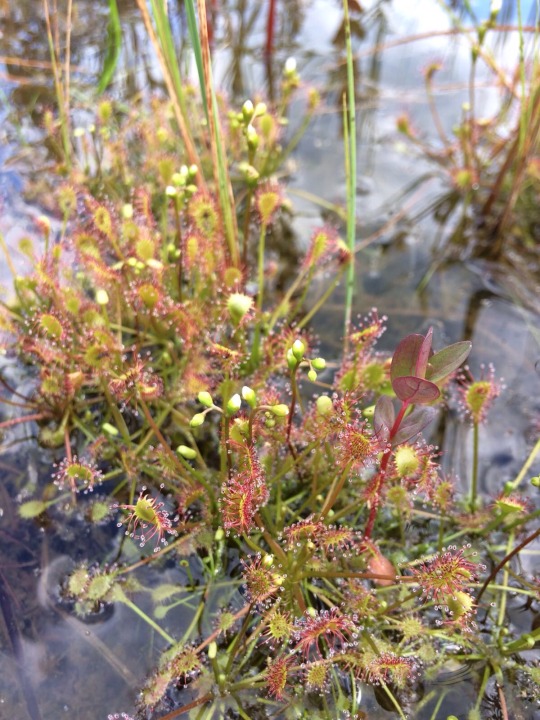
(Carnivorous Round Leaf Sundew. Perron,2019)

(Leaf of a pitcher plant, another carnivorous bog plant. Perron,2019)
Climate Change
Bogs take hundreds to thousands of years to develop they create a soggy soil composed of mostly dead organic matter called histosol. Peat is formed from the breakdown of histosol. Peat is a fossil fuel and the first stage of becoming coal. Humans have harvested peat as an energy source, while it is a renewable resource the length in which it takes to form is extensive. Bogs do a process called carbon sequestration, where carbon dioxide is removed from atmosphere and stored in the peat.
Bogs are also super important because of the amount of water they can hold; they are flooding buffers. While they work as amazing climate mitigators they are also a great habitat for many different species of insect, amphibian, reptiles, birds and even mammals utilize bogs to find food or shelter. Many threatened and endangered species around the world’s primary habitat is a bog (National Geographic, 2021).
Bog Bodies
Bogs are incredible at preserving remains. Bodies thousands of years old have been found in bog, the low oxygen and acidic soil preserve the bodies remarkably well. So well in fact they retain an unbelievable amount of detail from hair, tattoos, skin, and internal organs. Bogs keep the bodies in the exact state they were laid in thousands of years ago. Archeologist have been able to deduce that most bodies found in bogs were done as a ritual sacrifice (National Geographic, 2021).
Conservation
Bogs are these amazing ecosystems and have this unique ability to bring folklore to real life. They are a vital system of the earths immunity against climate change and protection of our peat lands should be an area of interest for all people. These incredible wetlands protect us from flooding and climate change by simply existing.
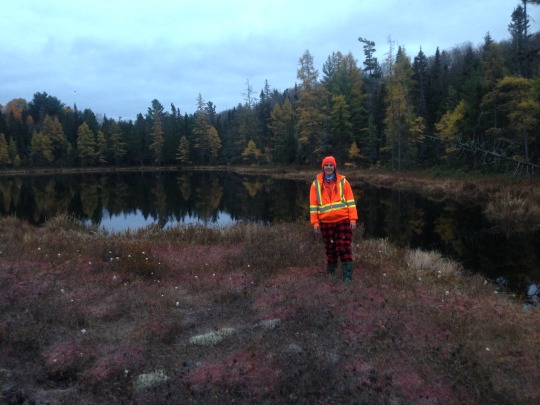
(My favorite Bog at my hunt camp, there are so many unique plants here. Perron, 2019)
References
Castelow, E. (n.d.). The Origins of Fairies. Retrieved from Historic UK: https://www.historic-uk.com/CultureUK/The-Origins-of-Fairies/
Meredith, D. (2002). Hazards in the Bog - Real adn Imagines. Geographical Review, 319-332.
Mosco, R. (n.d.). Bird and Moon Science and nature cartoons.
National Geographic. (2021). Bog. Retrieved from National Geographic: https://www.nationalgeographic.org/encyclopedia/bog/
Perron, 2019. Plant Photos
2 notes
·
View notes
Text
Hi Jenny,
Great Post! It is so incredible how smart some animals are. Corvid family members share that intelligence and problem solving abilities. There has been research done on Ravens to explain their sharing behavior. These researchers aimed to explain altruistic behavior seen in ravens. During the winter ravens who find carcasses will circle and fly away returning later (hours or days) with numerous other ravens to share the find. This behavior has been repeatedly studies and shown to be due to a drive in self interest and common good of the group. This means by implying this sharing method the raven is more likely to have continual access to food over the entire winter. (Heinrich, B & Marzluff, J. 2013).
I think that many animals have more intelligence than we as humans give them credit for. Our issue is that we prioritize and hold some abilities as more important and deemed “more intelligent”. An appreciation of the survivability and application of different species survival skills should be considered. I think that species like crocodiles, sharks, turtles who have remained physiologically and behaviorally consistent should also be classified as intelligent. They have figured out the ultimate system of species survival.
But the appreciation of learning in animals is such a neat concept and shows the adaptability and “human” like pattern thinking in Corvid family groups.
Reference
Heinrich, B, & Marzluff, J,. 2013. Exploring Animal Behaviour: Readings from AMerican Scientist, Sixth Edition
The Intelligence of Crows
Nature is full of incredible, sometimes unbelievably exciting things.
American crows (Corvus brachyrhynchos) are amongst some of the most intelligent animals in the world (Baraniuk, 2019).
Crows are very social, living in groups called “murders”. Sometimes these groups can be in the thousands, which must be quite something to experience. Crows are adaptable, playful and often very curious. Crows are also known to be trouble-makers, but I think it makes them resourceful and excellent problem solvers! These beautiful birds knock over garbage bins and scavenge snacks wherever they can, which can make them messy in urban areas, but also allows for their survival in their urban niche (Cornell Lab of Ornithology, n.d).
Humans have known that crows are incredibly sly for a long time, but in recent years research has shown that perhaps they are even smarter than we initially thought (Baraniuk, 2019)!

New Caledonian crows use branches and sticks to dig out insects and grubs from trees. (Credit: Alamy, BBC Earth 2014)
New Caledonian crows have evolved such that creating and using tools is part of their typical foraging behaviour. This was first seen by researchers at the University of Oxford in 2002 when Betty, a New Caledonian crow, bent a piece of wire to create a hooked tool in order to scoop up some tasty pig heart. At the time, Betty was thought of as an incredibly intelligent crow, but now research has shown that this clever ability is widespread throughout the corvids (Baraniuk, 2019). Though, this is not to negate Betty’s clever abilities!
Since this incredible feat of Betty’s was witnessed by researchers, the nature of these birds’ cognitive abilities has been studied closely.
https://www.youtube.com/watch?v=cbSu2PXOTOc - A crow completing an intricate puzzle in order to get a food reward.
The video linked above demonstrates a crow nicknamed “007” solving a puzzle with eight distinct steps in order to get a reward of a snack. Though puzzled at first, the smart creature quickly sorts out the steps he needs to take in order to accomplish his task and acquire his treat (BBC Earth, 2014). Watching videos like these, or even watching crows out in nature in urban areas and green spaces, makes me feel a personal connection to them. For me, it leaves me in a state of awe watching birds use their memories, problem solving skills and pure cleverness, to solve a relatively challenging task. I think for me, it makes me feel as though we are so much closer to nature than we feel we are. Crows are brilliant animals, and their playful and mischievous ways make me feel like we have a connection to them that some many not acknowledge. Crows can remember human faces- they remember those that have wronged them and will never forget. Crows are known to swoop down on people that have caused them harm before, along with other members of their murders! They also trust humans that feed them, and will come back to those they trust.
Is there any animal, or any element of nature, that makes you feel more connected to nature? Crows continue to amaze me more each day. What aspects of nature stir up these feelings in you?
A quote from the book, “Gifts of the Crow- How Perception, Emotion, and Thought Allow Smart Birds to Behave Like Humans” by John Marzluff and Tony Angell, that struck a chord in me, when referring to infrared camera imaging of crows to determine what part of their bodies were working the hardest.
“And the crows’ heads were lit up like holiday lights. The energy of thought and coordination illuminated a darkening sky like strings of flying light bulbs.” (Marzluff, Angell, 2013).
References:
American Crow IDENTIFICATION, all about Birds, Cornell lab of ornithology. (n.d.). Retrieved March 19, 2021, from https://www.allaboutbirds.org/guide/American_Crow/id
Baraniuk, C. (2019, December 11). Crows could be the Smartest animal other than primates. Retrieved March 19, 2021, from https://www.bbc.com/future/article/20191211-crows-could-be-the-smartest-animal-other-than-primates
BBCEarth. (2014, September 10). Are crows the ultimate problem solvers? | inside the animal mind | bbc earth. Retrieved March 19, 2021, from https://www.youtube.com/watch?v=cbSu2PXOTOc
Marzluff, J. M., & Angell, T. (2013). Birdbrains Nevermore. In Gifts of the crow: How perception, emotion, and thought allow smart birds to behave like humans. New York: Atria Paperback.
6 notes
·
View notes
Text
Finding that Nature is Music
Music can be used as a form of communication. Historically, it has been used to tell stories and educate. Nature can be interpreted and described to people using music, this can help reach many different people by incorporating multiple learning styles. For auditory students listening to a melody and song can be really inspiring and the tune will probably get stuck in their head leaving a lasting memory. Hand gestures and dance can accentuate the music and allow for more visual people to learn and finally using an instrument to make the noise or using your body to make music will appeal to many tactile learners.
From the rain, to the wind to the cricket chirping nature makes music. Her rattle of a snakes tail sings danger and her birds singing can mean joy. The communication of animals is music. As humans we speak and while to us this might to be “music” but to the dog listening to your voice; Do they think your communication is beautiful music?
Growing up, my sister and I, listened to this tape called “Real Wolves: wild songs for kids” by Mandi Kujawa. I spent an hour scouring the internet in attempts to find this album of fun and factual animal and nature songs but unfortunately it predates the internet and is not popular enough to have made it to the 20th century. I am fortunate that I found my existing copy. This tape shows the awesome educational aspect that can be used to teach children in a fun dynamic way. One song in particular that I will 100% sing the chorus to myself if I ever got lost is titles “Lost in the Woods”, it is a great way to teach survival skills to kids and give them the confidence they might need if they ever did find themselves in this situation.
Lost in the Woods
Boy:
In the woods with my parents one day
A park warden came our way.
She talked to us of bats and bees, then she spoke directly to me:
Woman (warden):
Glad to see you with your family on trails marked clearly,
But if you’re lost and get confused
This song reminds you what to do
Chorus:
If I’m lost in the woods
I’ll stay in one place,
Find a big tree to shelter me,
Sing to keep calm and make a bed
With the tree above my head
Boy:
As soon as I know I’m lost I’ll stop
My parents and many other people will be looking for me,
And I’m much easier to find if I stay in one place
(chorus)
Boy:
While waiting fo help I’ll make a heap
Of grass, branches and leaves piled deep.
If night comes that’ll be my bed,
I’ll keep a hat upon my head.
(chorus)
I’m no to answer strangers usually,
Unless I’m lost and they’re looking for me.
The warden said: Stand in the clear, then wave and shout: “I’m here! I’m here”
(chorus)

(My copy of Real Wolves; Wild songs for kids by Mandi Kujawa; Perron,2021)
Changing to Create Someone Version of Perfection
DJ Ecotone delightfully turns natures music into a more western style vibe. This can help reach the people who have limited imaginative capacity and find difficulty in hearing the music in its natural rhythm and tones. I can appreciate that for many hearing the works of Mr. Mirin was pleasant and interesting, but I found that it removes the fragile beauty of these sounds and calls. The definition of music is: “vocal, instrumental, or mechanical sounds having rhythm, melody or harmony” (Merriam-Webster Dictionary, 2021). These qualities are representative of sounds hear in nature, therefor we could interpret nature sounds to be music. Appreciating an art the way it is and not attempting to change it into something that “fits” our liking better is challenging. We can see this all the time in society. For example, many foods from different cultures get Americanized to taste and be more appealing to folks who grew up with a different style cuisine. The appreciation for things that are different and not in our comfort zone takes a willing and open mind. The world is fascinating because of the ways that it is different and not in the ways it is the same.
References
Merriam-Webster Dictionary. (2021, March). Music. Retrieved from Merriam-Webster Dictionary: merriam-webster.com/dictionary/music
Perron, N. (2021). Real Wolves: Wild songs for kids, fun factual animal and nature songs.
0 notes
Text
I had never heard the song “Don’t Fence me in before” but I must agree the song has many vibes of freedom and openness in nature. I personally have an opposite attraction to nature, while I do enjoy a beautiful scenic view and wide open skies above me, there is something about a canopy of trees over my head that make me feel incredibly close to nature. The muffle sounds in a forest are some of my favorite ones like raindrops on the leaves, birds calls echoing from a distance. The magic for me is under the trees.
I quite enjoy the calming effects of natures music, I was in an accident a few years ago and suffered PTSD, I had issues falling asleep, staying asleep and getting an actual deep REM sleep. I tried all kinds of things to see what would best help me recover. This is how I discovered meditation. I meditate almost every night as part of my routine, I use to listen to guided meditations but have taught myself to self meditate so I could “go” and explore whatever I wanted. I love to guide myself on adventures in forests exploring hallows, swamps listening to frogs, bugs, birds and fish or turtles splash into the water. Sometimes I plays nature sounds and base my meditations off them, the real sounds solidify the relaxing feeling as I fall asleep.
Listen
Imagine you are driving down a barren highway, windows down and your hair whipping around in the sunlight. Maybe to one side you have colourful trees for as far as you can see, and on the other the ocean with the sun dancing on the surface. Moments like these have a way of working into your heart, giving you that wanderlust feeling, but something is missing from this image. In the backround of it all you hear music. Maybe it’s the song of the birds that are swooping down into the water, or the roar of the wind on your ears, or maybe its simply a song playing on the car radio. But now, when you think of the chorus of that moment, you will be able to remember the feeling you had, and the love for the world it made you feel.

For me, I am constantly flipping between listening to the music on my phone and enjoying the music that nature offers. Like a song, there are elements in nature that follow a rhythm, maybe it’s the pounding of a flowing river, or the hollow knocks of a woodpecker. There is beauty in having the world sing to you, but there is also beauty in allowing a song to inspire you as you look out at the world. It is the mix of two beautiful things. Art in nature surpasses just looks, as animals communicate they are expressing themselves through different tones and octaves, giving us the pleasure to interpret what they are saying. Can you hear the distress with which a red squirrel belts to its mate? Or the longing in the song of a bird that tries so hard to be the one that’s heard. Humans are capable of hearing the music of so many species, it is up to us to listen.

Often listening to the sounds of nature has a calming effect on me and allows me to tune out all distractions. Some sounds from nature that I adore are:
· Crickets chirping
· Water running
· Wind howling
· Storms raging
· Birds singing
· Squirrels being crackheads
It is not entirely up to nature to sing about its wonders, people need to sing their experiences and spread the feeling nature can give. While some songs are specifically dedicated to learning about nature, for example “Canada’s Really Big” by the Arrogant Worms, a comical song about the Canadian landscapes and wildlife. While other songs are about the emotions that nature can provide and the longing people may feel. An example of a song that always makes me think of the freedom that nature makes me feel is the song “Don’t Fence Me In” by Roy Rogers. The lyrics of “Don’t Fence Me in” accurately explains my fear of ever being too far from nature.

“Don’t Fence Me In” has never brought me back to a specific memory, it merely makes me feel free. I picture myself in a sunny field smiling (because I am always smiling when I’m in a sunny field). To me it is a song that I do not need others to like, because to me it is a promise that I will be in nature again, maybe not immediately, but I can hold onto that image until I get to the wide open country that I love.
Lyrics to Don’t Fence me In by Roy Rogers (Retrieved from GENIUS)
Oh, give me land, lots of land under starry skies above Don’t fence me in Let me ride through the wild open country that I love Don’t fence me in Let me be by myself in the evening breeze Listen to the murmur of the cottonwood trees Send me off forever, but I ask you please Don’t fence me in Just turn me loose, let me straddle my old saddle Underneath the western skies On my cayuse, let me wander over yonder Till I see the mountains rise I want to ride to the ridge where the west commences And gaze at the moon until I lose my senses I can’t look at hobbles and I can’t stand fences Don’t fence me in Oh, give me land, lots of land under starry skies above Don’t fence me in Let me ride through the wild open country that I love Don’t fence me in Let me be by myself in the evening breeze Listen to the murmur of the cottonwood trees Send me off forever, but I ask you please Don’t fence me in Just turn me loose, let me straddle my old saddle Underneath the western skies On my cayuse, let me wander over yonder Till I see the mountains rise I want to ride to the ridge where the west commences And gaze at the moon until I lose my senses I can’t look at hobbles and I can’t stand fences Don’t fence me in
5 notes
·
View notes
Text
The Power of Knowledge Sharing
How can the past be used to help make a better future? Will the lessons learned in the Past help reduce the mistakes of the future? These are a few of the questions that should be considered when thinking about teaching historical events.
Without applying a perspective to teachings and stories of the past, that is all they will ever remain. Without a lens of learning and progress, we are doomed to repeat the same mistakes of the past. To use history as a fable instead of just a story can instill morals lessons that stick with people for much longer and have a ripple effect. For a minute just think about the fables you possibly learnt as a kid. I for one automatically think of the Tortoise and the Hare, the details of this exact fable are a little fuzzy but the phrase “Slow and Steady Wins the Race” has been a part of my vocabulary since I was very young. What did this teach me? Patience, that doing things right the first time is better than doing them quick and skipping steps, that faster is not always better. In my adult life, I tell myself this to remind myself to take my time, consistency is key, that I will get there when I get there.
To best give an area/culture/object/story relevance from its past to it is present takes reflection. What important lessons can be learnt and used to teach a lesson that is current? To teach and understand what has happened to the land and explain why it is configured a certain way this can give foresight to obstacles that might be encountered in the future. Allow to take a proactive approach instead of a reactive one.
Intergenerational Knowledge Sharing
Stories, conversations, ideas, listening. These are some of the main ways we can absorb knowledge from the generations that precede us.

(Knowledge sharing with Youth and Elders. Perron, 2020)
The value of spending time with someone who is willing to share their knowledge with you is a priceless endeavor. I would encourage everyone to spend time with an Elder they respect and listen to their stories, ask questions about their lives. I can guarantee, there will not be regrets about that time spent with them and only wish you had more opportunities.
It is All about Perspective
In Week 2 blog “Who I am as an Interpreter” I shared the creation story of the Blanding’s Turtle told to me by an Elder and then again by a friend in further detail to be able to use this story in my writing in conjunction with the University of Guelph. I have included the story below for reference. While reading the story, I would love for you to think about the possible lessons it gives us.
‘Nanabush is a trickster spirit that is half human, and he decided to take the sun from the sky. Without the sun the world fell into a cold dark winter, many different animals much stronger and faster than the turtle tried and failed at returning the sun to the sky. Most animals where afraid of Nanabush, but a small turtle decided he would try. While Nanabush’s was asleep the little turtle crept into his house and put the sun into his mouth. The little turtle held on tight so not to let any light out, any light that would wake Nanabush. He then released the sun back into the sky, returning life to the world. As thanks for his bravery the little turtles throat was stained yellow giving him the name “the turtle with the sun under its chin”.’ (Noganosh, 2020).
This story is by far one of my favorite creation stories. I think there is so many great lessons to take away from it and turtles are just turtally awesome. I think this story is teaching us to not judge based on size or appearance. That courage takes all shapes and forms. That what seems to some like a “moving rock” might be more important to the world than originally perceived. Turtles have such a valuable place in ecosystems, keeping our wetlands clean and therefore the water clean. They metaphorically give life back to the world but the physically keep life stable in wetlands. Every piece of an ecosystem has such dynamic interactions that removing one aspect could have a cascading effect to the rest of the web.
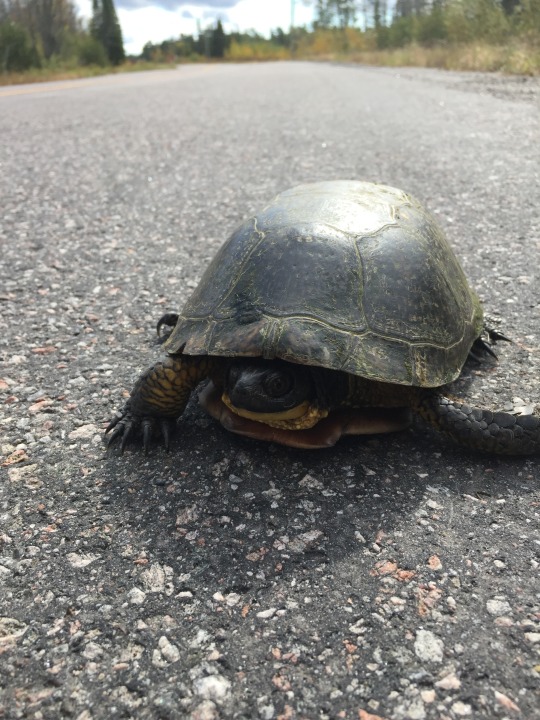
(Blanding’s Turtle on the Road, Perron, N. 2020)
The quote from Albert Einstein:
“Everybody is a genius. But if you judge a fish by its ability to climb a tree, it will live its whole life believing that it is stupid”
really offers a lot of food for thought. It tells us that we must understand how things work to be able to properly evaluate them. To be able to make decisions in the present, we must know the past so we don’t mess up the future.

(Dr. Zam’s Learning Studio, 2021)
References
Noganosh, S. (2020). Ojibway Creation Story of the Blanding's Turtle. (N. Perron, Interviewer)
Perron, N. (2021). Photography is my own work unless indicated otherwise.
0 notes
Text
I think you hit the nail on the Head with the order in which you listed the importance of Present, Future and Past thinking. I would like to draw a connection between the rating of these and connections with Mental Health in the human population. It has been studied about the connection in spending brain time in a rumination on the past and future thinking state with connections to depression and anxiety (Lavender & Watkins, 2004)(Beaty et al. 2019).
The Stick, Rock and Leaf game sounds like a great skill that could be taught to kids in giving them tools of self-help and feel positive connections out in the environment.
In terms of Past thinking and the infamous Winston Churchill quote. I personally believe that basing a future plan referencing the past can narrow our thoughts and limit the creative potential possible. Learning from the past can only take you so far as human ideas and intentions are so complex that unless thoroughly explained it is impossible to completely understand why a person did the things that did. Most relevant historical events have many assumptions and inferences drawing connections to the reasoning. I think it is best to use a multi faceted approach to tackling problems.
Lavender, Anna., Watkins, Edward. (2004). Rumination and future thinking in depression. Institute of Psychiatry.DOI: 10.1348/014466504323088015
Beaty, Roger E., Seli, Paul., Schacter, Daniel L., (2019). Thinking about the past and future in daily life:an experience sampling study of individual differences in mental time travel. Pyschol Re.83(4):805-816. doi: 10.1007/s00426-018-1075-7. Epub 2018 Aug 20. PMID: 30123945; PMCID: PMC6382594.
Present, Future, & Past
This is how I order these by importance. If we are too occupied by the past or future, we ignore what is happening now and miss the opportunity to interact and enjoy the things happening now. Setting goals, being mindful of the outcome you want, planning; all of these acts as guides to helps us in the present and are only worthwhile as such, as focusing too much on the future can create anxiety. Using history, our mistakes, our regrets, our “what-if” to change and inform our decisions about our present and future are of course important but if we become to focused on these we become stuck and/or hopeless. That being said, none of these exist or should exist without the others because each have value to helping us grow and live meaningful self-aware lives. Does you order of importance differ?
Stick, rock, leaf: An exercise for reflecting on time

Taken by Jacob Kannel from Unsplash.
When you want to help your audience reflect on their experience (especially a younger audience) this was a helpful tool I discovered. Ask them to collect a stick, a rock, and a leaf and have them say one thing that will “stick” with them (future), something that “rock-ed” (present), and what they want to “leaf” behind (past). This helps them to engage with their experience in the context of time.
Engaging with the Past
“There is no peculiar merit in ancient things, but there is merit in integrity, and integrity entails the keeping together of the parts of any whole, and if these parts are scattered throughout time, then the maintenance of integrity entails a knowledge, a memory, of ancient things. …. To think, feel or act as though the past is done with, is equivalent to believing that a railway station through which our train has just passed, only existed for as long as our train was in it.”
(Edward Hyams, Chapter 7, The Gifts of Interpretation)
In this quote, Hyams is stating that while old things aren’t inherently more valuable, there is value in what they tell us.
“Those who fail to learn their history are doomed to repeat it.”
(Winston Churchill)
I am reminded of the over-quoted warning of not learning from history and as someone who is really interested in conservation, this is something I often think about when it comes to analysing conservation and management strategies. While our history is often sad, we have lost so many species due to humans impacts (overharvest, climate change, pollution, etc.), it is important to explain this to your audience with a message of hope. As I said earlier, past without present and future leaves us stuck, making it crucial to share our history to show our progress and encourage further growth.
“Yes our coral reefs are in danger but we are doing amazing things to combat this like using 3D printers to make artificial substrates to regrow coral!”(1,2).
youtube
1.Perry, C. T., Alvarez-Filip, L., Graham, N. A., Mumby, P. J., Wilson, S. K., Kench, P. S., … & Macdonald, C. (2018). Loss of coral reef growth capacity to track future increases in sea level. Nature, 558(7710), 396-400.
2.The Edition. (2018) Summer Island’s 3D Printed Artificial Coral Reef. Retrieved from https://www.youtube.com/watch?v=Nc5SBCw_DJo&ab_channel=TheEdition
11 notes
·
View notes
Text
Making it Fun, Helps make it a Habit
It has often been brought to my attention by friends or peers that they envy the amount of time and activity spent by my family outdoors. I was raised outside, we camp, canoe, hike, run, bike, snowshoe, ski and pretty much are willing to try anything at least once. So I often never think about how abnormal this may seem to some individuals. I realize now that growing up in an active family made enjoying and being outside a habit, but also attitude is EVERYTHING.
In my personal opinion, if you ain’t having fun, you’re not doing it right. I’ve taken friends out for beginner hikes often with comments of comparison how they are tired or not as able as I, but like anything you need to train. You can’t hike once and think you are ready to tackle Mnt. Everest. The mindset of “I should be good at things, the first time” is such a plague of our generation. If you are always comparing yourself, you will never be happy and if you aren’t happy you won’t enjoy getting outside.
Some tips and tricks, I have tested and found effective over the years are:
1. Be Goofy: The only thing you are focused on when your being goofy is having fun. You aren’t worried about keeping up with the Jones and you aren’t checking your fit bit every five minutes to see how far you’ve gone. You are enjoying the moment, the laugh and you are making good lasting memories.

My friend Alanna and I taking pics while skating on Georgian Bay.
2. Investigate your surroundings: Hear a bird call you’ve never heard? See a stream and want to know where it leads? Learning about the world that surrounds you can lead to comfort and entertainment for your brain while your body enjoys its vitamin D. I personally like to do high speed tree identification while I’m running, skiing, biking. Learning about the different trees tells me about the habitat type, what types of animals I could find. Plus trees are so unique and they each have their own story.
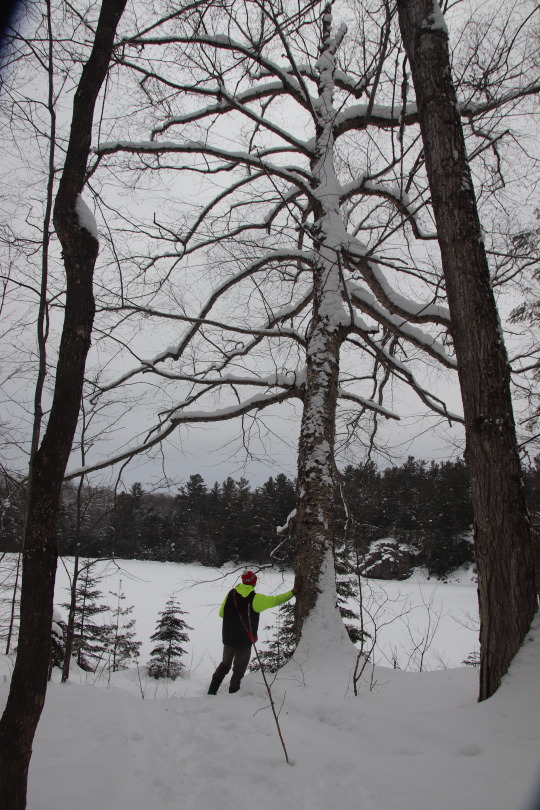
.My Partner and the biggest Yellow Birch (Betula alleghaniensis) we have ever seen. Which is saying something because my partner is an Arborist by Trade.
3. Go with your pet: Those cold days you want to curl up in front of the fire and never leave your house. I know I have those but I always take my best buddy out for a hike because he deserves it. Pets can be great motivators to go for that extra KM or explore a remote area so he can run off leash.
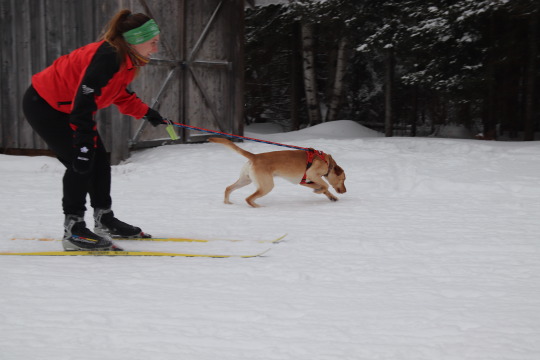
Teaching Fin to do Skijoring. This was his first time. He is turning into quite the ski dog these days.
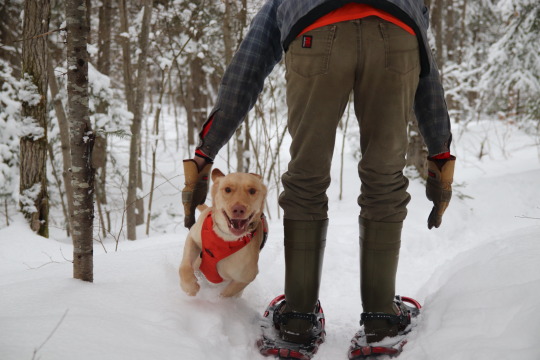
Snowshoeing with Fin. He is such a happy boy and LOVES to be outside.
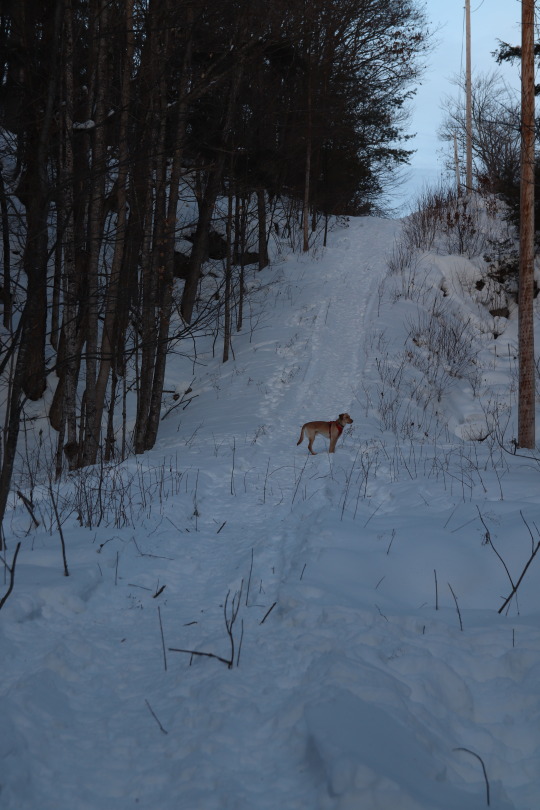
I call this hill “ problems” and I ask Fin every morning if he wants to go tackle our problems. Trust me its quite a bit steeper in person.
These are just my top recommendation on how to change your perspective on outdoor activity. Doing something that you think is FUN will make you want to do it more often. I’ve been told that the more often you do something the easier it becomes a habit. Getting outside is a good habit to have (as long as it’s 6 feet away from the next person, for now anyways).
9 notes
·
View notes
Text
This was such a great journey through your art. I am not an artist and I don’t usually find it very therapeutic but it is interesting to share your perspective on perfectly imperfect pieces. This is potentially why I chose not to pursuit art due to my lack of ability to create the piece I envision in my mind, and thus by changing the perception of what the final project should look like I could possibly enjoy the creative process as you mentioned more. You really demonstrate how using art can be portrayed to change mindsets and beauty is what we each perceive it to be. A “flawed” piece of art has beauty in its mistakes and imperfections.
Relationship between art and perfectionism, and how it relates to nature.
Recently I started working on this project with a group of folks in Guelph, called F*ck Perfect. It works with you on a journey of self discovery and finding growth, or achieving whatever you want. They also break pre-existing notions set by society around art and perfectionism. We grow up feeling and learning that to do art, we need to be perfect, or the end goal is something perfect. It works towards breaking these notions and starting on a journey of creative risks.
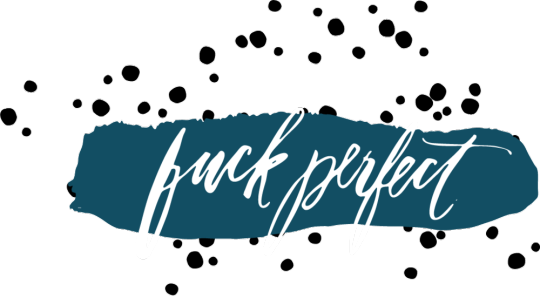
Art Not Shame, Guelph- Fuck Perfect Workshops.
Ever since I started working on this workshop, I realized how many times when we are expected to do something, we try to be the best or feel like we failed. During lockdown (all the versions of it :D), I started working on a new type of art. I have done water-colour, acrylic, soft pastels, repairing jewellery, journalling, crochet, embroidery, craft, drawing, and what not! And every time I did something new, I would be too focussed on the end product- to make it beautiful and perfect. I never reflected on how the process made me feel, why was I doing it. By journalling for this workshop and later processing things, I realized that it was during the times that I was painting, I was processing my feelings with COVID-19, being isolated, struggling with work, and being burnt out. While I was stressing about making that piece perfect, I forgot about the fact that the process of making that piece of art (moving the brush on the canvas, needle on the cloth) was actually very therapeutic and was actually the best stress buster.

The painting that I made through the university’s art stress buster series, December 2020- photo taken by me.
Why am I talking about this when talking about nature interpretation? Something that I noticed while reading through multiple posts was folks fixation on “good art” by “great artists” can create feelings/connection with nature. I don’t think that is true. I think every small piece of art, made by anyone, can play a role in nature interpretation. While my favourite poem is by Oscar Wilde, I do enjoy the random rhymes that slip into conversations, and honestly its these rhymes and not poems by great poets that I remember with a smile on my face. I think every small piece of art- grainy/unfocused pictures, undeveloped music, a kid’s stick figure drawing, journal entry- literally anything that speaks to you, can be a great interpreter. You just have to allow yourself to appreciate it.
As a way to incorporate this in my life, I took a little advice from my friend, and I no longer throw away art that does not look like what I wanted it to be. I used to call it mistakes, but now I just call them creative opportunities! I will paint over them or try to draw something with a black marker on them and integrate it together. Or, I just leave them as is, just cause they still remind me of the sunset I saw! Others might not see they same sunset as me, but I know what it means to me and what it remind me of. Hopefully, to others, it reminds them of something else they saw! In my small ways, I am fighting the urge to be perfect and embracing my imperfections.
How do you think you could break the pressure to be perfect and embrace yourself?!
6 notes
·
View notes
Text
Beauty in the Eye of the Beholder
Some of the most remarkable pieces of art can be related back to nature. When I think of art, I picture the works of the Group of Seven or Van Gogh, these artists saw the natural beauty of our world and captured it essence on canvases. Art has transformed in the age of technology it now allows detailed moments to be captured in their entirety. This has connected people and open the doors to exploration where it instigates places for travelers to go but it also enables those to experience these places from the comfort of their own homes.
To see the world through the eyes or lens of another is to visualize and be open to a different perspective. If you ask 10 different people to look at the same landscape and divulge what they “see”, I will wager that you receive 10 vastly different answers. These answers will depend on the background and past experiences of each individual. Looking at a landscape can be comparable to looking at abstract art, each time you look at it, every angle or distance from the view brings new light and perspective that may not have been noticed the time before. It allows each individual to feel something truly unique to them.
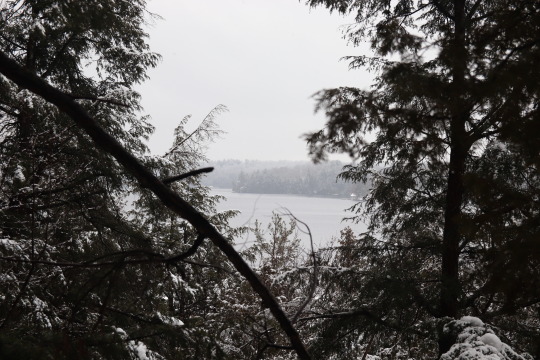
This is my Dog and I’s favorite Lookout spot. It can be magical when the snow has fallen on the trees to peek out at the Lake
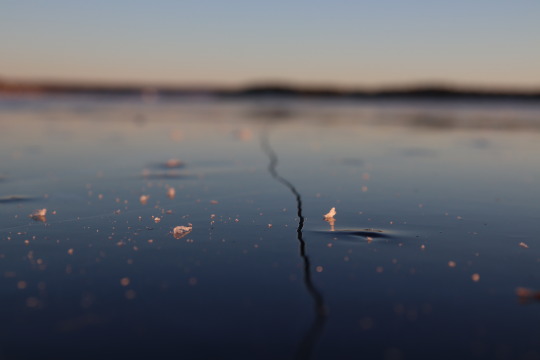
A pressure crack in the ice on Georgian Bay. Simple, yet very symbolic.
If I say the word beauty what comes to mind? Maybe fashion models, beautiful jewelry, or the most colourful sunset. Beauty is in the eye of the beholder. An ice storm that freeze to every surface it contacts to some might be an ugly side of nature but an optimist might slap on their gripp”ies” and go for a walk to revolve in the beauty the ice storm has turned the forest into. To see the frozen droplets on a tree making them shimmer in the light or to hear birds chirping after the storm is over and the sun has come out. The gift of beauty is to be able to see the beautiful things that are already in front of us. To recognize and acknowledge the majestic beauty in everything. To look at an ant hill and see the teamwork and amazing architecture of the little pile of sand in front of your toes. To chose which type of lens in which you want to view your life through and then use that magic to inspire and let others know that seeing beauty isn’t something you need to search and travel across the world to see but to search within one’s self to change a perspective and chose to see the wonders right beneath out feet.
This is how using art to interpret nature speaks to me. Artwork is example of how something was interpreted as beautiful and meaningful no matter its simplicity or commonness.
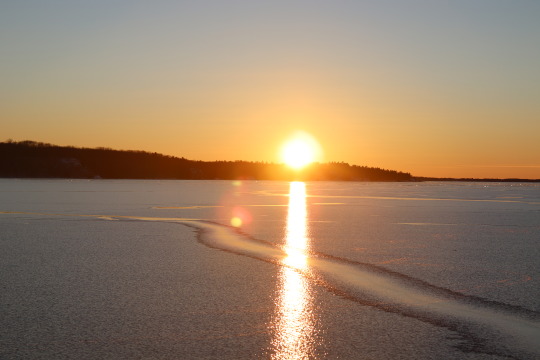
2 notes
·
View notes
Text
Internal Check List
The Oxford Dictionary defines the noun privilege as: a special right, advantage, or immunity granted or available only to a particular person or group. While this is a great dictionary definition, I think it has such a deeper meaning and plays a role in society due to years and years of narrow-minded thinking. My definition of privilege is the right or access to something because of external factors out of your control. This includes but is not limited to social classes of privilege due to the colour of skin, gender identity, sexual preferences, income, education. It is often something that is overlooked since many people do not acknowledge their own privilege.
One of the best ways to ensure that your privilege does not coheres your nature interpretation is to acknowledge it. I am a White, Bilingual (French and English), Female from a middle-class family. I have two parents that are married, an older sister and a later life addition of a brother-in-law. I have been privileged enough in my life to participate in many sports at many different levels, to educate myself by finishing high school continuing at college and university. I was blessed with parents that saw value in exposing my sister and I to nature from a very young age.

My Family and I at our Hunt Camp
Nature Interpretation is such a multifaceted industry, every story can be told and interpreted so many ways. Knowing your audience is important as to navigate your interpretation to best suite their needs and wants. Taking kids from a private school in the city would look very different than going out with kids going to school in the school system on a First Nation. These groups would have different values, social classes, and appreciation for the environment around them.
I understand that how I was raised and who I am, has given me certain privileges and enable me to achieve certain things in life that may take another a different type of struggle to achieve the same results. It is a huge feat to be able to place yourselves in the shoes of another and visualize life and its struggles from their perspective. But to also acknowledge that what you visualize and imagine is probably not nearly close to the real feelings and struggles each individual encounter in their life.
Be compassionate, be passionate, be understanding and use the privilege that you were given to help lift those around you. To educate with patience and positivity. To realize that every encounter could possibly change someone’s life. The teenager that is making fun of your presentation may be learning and enjoying it more than you could possibly comprehend. Remember, that we all come from different walks of life with different privileges, but these can either bring people together or separate them further apart. Be a role model, as an interpreter that makes the world and its people a better place.
If anything is taken away from this blog, I hope the values of compassion, passion, understanding, patience and positivity should be expressed in all works of a nature interpreter.
2 notes
·
View notes
Text
I did not know that they gave cheetahs their very own guide dog puppy as a conservation effort. That is probably the cutest thing I have every heard. The Toronto Zoo is a really great organization that has the ability to make impacts on species at risk. An Ontario example of their work is the reintroduction of Blanding's Turtles in Rouge National Park. This endeavor requires collecting, incubation, head starting, releasing and tracking turtles as they monitor population size. I think it is really neat to have an example of Conservation right here in our own backyard as often with exotic species it is hard to put in perspective the importance of these efforts to us here in North America.
Wildlife Nature Interpreter!
My Ideal Nature Interpreter job would be working with animals to increase awareness about their behaviors, habitats, and body language, with the aim of helping to revive their habitat and reduce points of conflict between humans and wildlife during interaction. Specifically, I would love to be a part of an organization that is a part of the Species Survival Plan.

Figure 1- Species Survival Program by Santa Barbara Zoo
Back in 2018, I spent a day at the Toronto Zoo and fell in love with the work of the zoologists and animal care teams there. During a conversation with one of the zoo keepers there, they mentioned how one of their female Sumatran Tiger was going to be sent to another zoo and a male will be brought in so that he can mate with the second female. The aim of the program was to help at-risk and endangered species procreate and eventually, when there is suitable habitats for them, releasing them in the wild.

Figure 2- Sumatran Tiger (Creative Commons)
This is not all what the Species Survival Plan does. Just having enough individuals of a population is not enough for a successful release. The individuals also need to have their natural instincts and learned behaviors to help them survive in the wild. This means developing different schedules for them to aid them in maintaining natural hunting, mating, and group behaviors. So, for the species of African White Lions, they had 3 individuals- one male and 2 females. The group is a representation of the hierarchies in the wild, one alpha male lives with a group of females! Furthermore, there was a clear hierarchy maintained by the 3 lions- Alpha male, followed by alpha female and then then third female- which was respected by the zoo keepers. In the open, during feeding time, the alpha male would grab the first meal thrown at him, followed by the alpha female. The submissive female does not try to get these meals and so the keepers would feed her more in the morning than trying to attempt to feed her later in the day with other members of her group, which could lead to conflict.
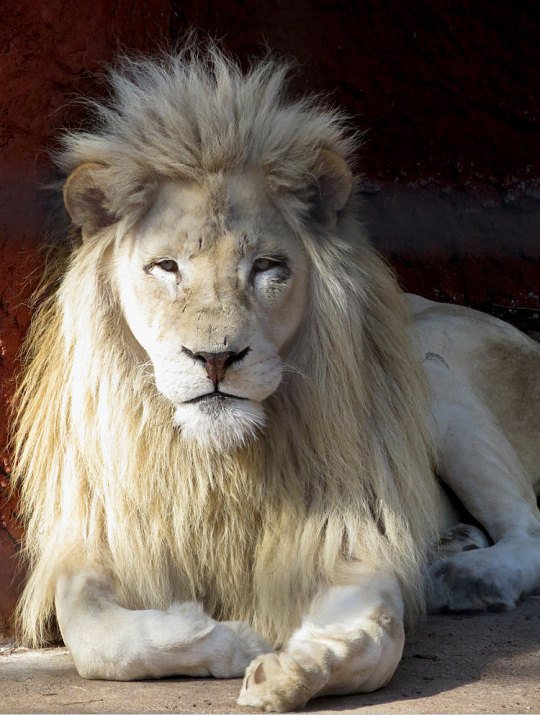
Figure 3- African white lion (Creative commons)
In addition, the program also aims to help find ways to eliminate barriers to population growth in the wild. For instance, cheetahs are solitary animals and are not social, one might call them introverts! So, a big barrier to population growth for them is not mating. They are so shy that individuals rarely have successful mating. So, to overcome this, cheetah cubs in many zoos are provided with guide dogs (puppies, to be exact)! How cute is that! The aim is that the cubs learn or become more social by learning socializing behaviors from their companions and will be more likely to interact and mate with a female of their species.

Figure 4- National Geographic- Relationship between Cheetahs and Guide dogs
This is how I want to contribute as a Nature Interpreter! While there are some people and organizations that take advantage of these programs by making false statements to maintain population in the zoo and make a profit, I want to use the good parts of this program and educate people about myths. I want to help various species and at the same time communicate with the public to increase awareness about the species and how to behave when they encounter one, without harming the individual!
I hope you enjoyed reading the blog! If you want to know more, here are some websites and articles I found helpful during my research-
Holland, J. (2017, August 03). Cheetah-Dog Friendship Isn’t As Strange As It Sounds. Retrieved January 24, 2021, from https://www.nationalgeographic.com/news/2015/10/151007-cheetahs-dogs-animals-science-zoos/
What is the Species Survival Plan®, and Why Is It Harmful for Elephants? (n.d.). Retrieved January 24, 2021, from https://www.idausa.org/campaign/elephants/latest-news/species-survival-plan/
18 notes
·
View notes
Text
I would have loved to have a counselor like you when I went to camp, your scavenger hunts sound really fun. I think teaching people about safety measure when out in the environment is such a great way to make people feel more confident about being outdoors. Knowing what to do in emergency situations can alleviate some anxiety people can have when placed in outdoor/new settings. This can encourage novices to push their own boundaries and learn to explore the environment on their own.
One of the skills I value as an interpreter is the ability to teach basic skills that people can be autonomous and go out and apply the knowledge for themselves. To be introduce them enough that they can go create their own memories and experiences that they can then share with others.
To answer one of your questions, I worked at a zoo one summer and lead some kids camps and did the interpretive talks with school groups. This was really rewarding and has helped me grow as an interpreter. showing kids the responsibilities of owning animals and caring for them gave them a greater respect for their own household animals and we didn’t have kids asking for a pony afterwards. It might sound like child labor but having them clean up after the animals gave them a sense of the time/effort and work required to own an animal.
What I Think My Ideal Role As An Environmental Interpreter Is
Throughout the years I am starting to really appreciate nature even more than before. This is based on experiences and things I learned from nature. This can be through environmental classes, hikes, and vacations. When it comes to nature interpretation I am not an expert or professional, but I do care a lot about nature and have a basic knowledge of our natural world and how it works. My ideal role as a nature interpreter would be in a role that informs and educates adults and children about the world of nature that we live in.
There are a variety of aspects of environmental interpretation that it may entail. One aspect would be teaching adults and children to understand the environment you are in and the safety measures needed to be made. When involved with nature especially in an outdoor environment safety is a top priority for yourself and others. Another aspect of the role is to make the interpretation to your audience interactive and creative. I believe an essential part of our roles as nature interpreters is to make a fun environment. Having things that are interactive will make everyone more engaged in the activity or lesson, and enjoy it. When I was a camp counsellor, I incorporated nature with my daily schedule for the campers to enjoy and understand nature. For example, I would include little scavenger hunts for the children to collect items from nature, such as pine cones, leaves, and sticks from trees. As a result of these activities, the campers had a lot of fun and had a better understanding of nature.

“Pine Cones - Scots Pine” by foxypar4 is licensed under CC BY 2.0
In general, with any informative environmental interpretation role that I may choose to do in the future, I would want to make sure that auditory, visual, and tactile learning styles are all included when appropriate. Having a variety of learning styles is very important for the people learning to help “stretch” their intelligence on the topic (Beck et al., 2018). This will provide an inclusive environment for whoever is learning about our natural world. This will hopefully result in people understanding and comprehending everything being interpreted.
For my ideal role as an environmental interpreter, I would prefer my job to be in an outdoor setting, specifically in a conservation area. I found when I am outdoors I have a better grasp, care, and understanding of the natural world. When being outdoors you get to experience things first hand and I find that is a great way to learn as you are participating and interacting. There are two important skills that I will most likely need for an informative outdoor environmental job. The first is having good communication skills, especially when presenting or trying to get an idea across. Another skill is having good teamwork skills to work with co-workers and provide a positive working environment. These skills will also help me with any group assignments I may encounter.

“21st century Learner” by giulia.forsythe is marked with CC0 1.0
Questions
What jobs/volunteer opportunities have you witnessed to find out what your type of learning style was?
Has there been a place you’ve been to that you love to talk about it to other people?
References
Beck, L. T., Cable, T. M., & Knudson, D. U. (2018). Interpreting cultural and natural heritage: For a better world. Sagamore-Venture Publishing.
Forsythe, G. 21st century learner [Digital Image]. Creative Commons. https://creativecommons.org/licenses/cc0/1.0/
Foxypar4. Pine cones - scots pine [Photograph]. Creative Commons. https://creativecommons.org/licenses/by/2.0/
2 notes
·
View notes